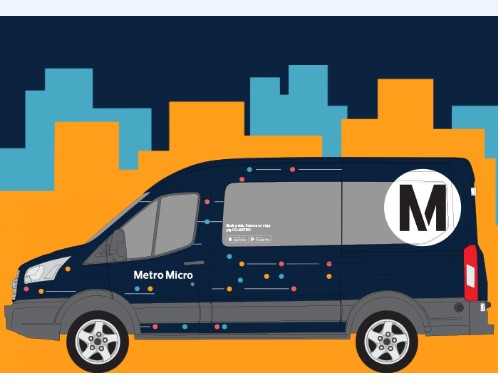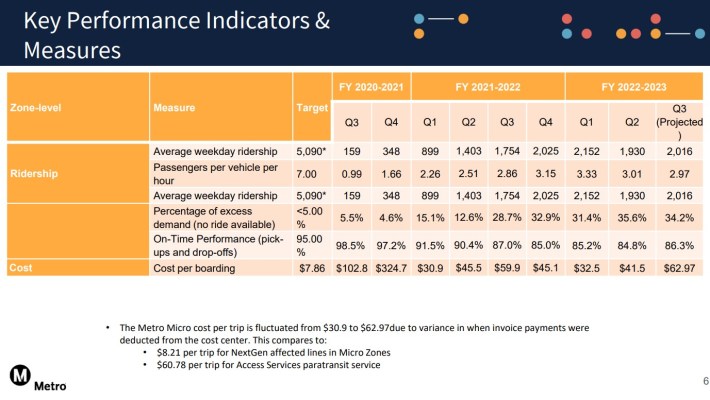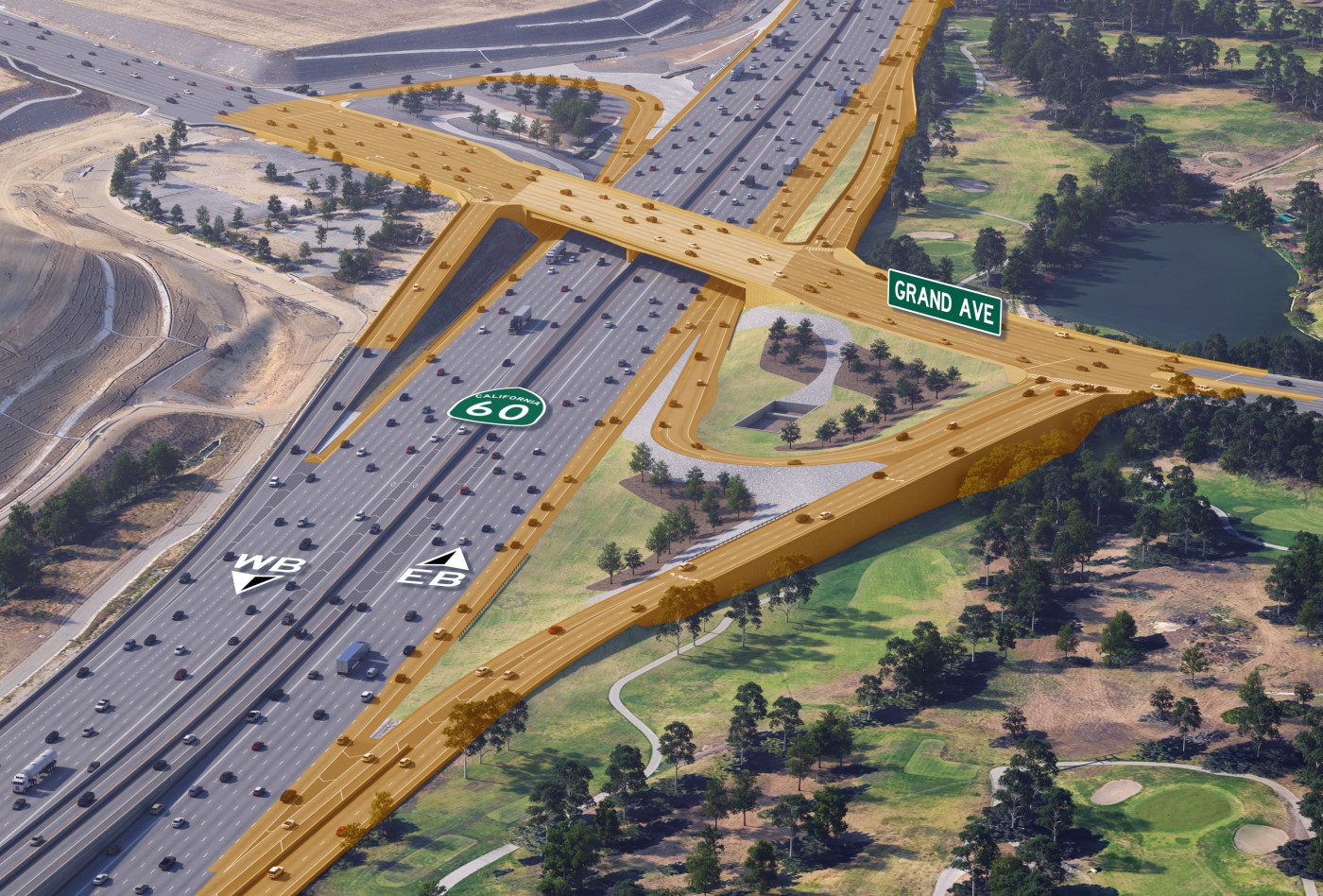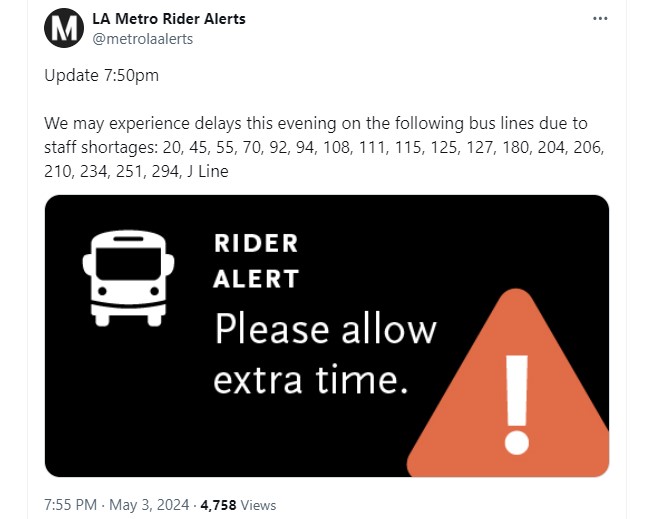Metro Poised to Waste $8 Million More on Costly ‘Metro Micro’ MicroTransit Pilot
3:15 PM PDT on March 21, 2023

Metro Micro is micro-effective microtransit. Graphic via Metro
It's your Streetsblog editor Joe Linton here. I initially tried to write this post in the relatively objective journalistic tone that Streetsblog generally favors - but I confess I just couldn't do it. Of all the wasteful spending at Metro (lots of freeway widening, problematic policing), the microtransit fad really gets to me. Metro Micro is taking away hard-to-find transit operations funding. The sooner Metro pulls the plug on this unsustainable pilot the better. Please, Metro, stop flushing operations dollars down the microtransit drain, and focus on fully restoring core transit service.
This Thursday, the Metro board will vote on a staff proposal to approve $8.3 million for a six-month extension of Metro's expensive, inefficient microtransit pilot, branded Metro Micro. Microtransit funding wastes Metro operations funding at a time when the agency is struggling to restore transit operations to pre-pandemic levels. The funding would be much better put toward reducing canceled bus runs or restoring rail service to pre-pandemic levels.
Briefly, what is Metro Micro? Basically Metro is trying to provide an on-demand ride-hail service, like Lyft or Uber. Anyone can book a trip on Metro Micro, mainly via its app. There are a few contrasts between Metro Micro and Lyft or Uber:
- Metro Micro only costs a buck to ride.
- It pays drivers as employees.
- It operates its own fleet, basically ten-seat shuttle buses (wheelchair accessible, but bring your own child seat/s.)
- It only serves limited service areas (Watts/Compton, LAX/Inglewood, NoHo/Burbank, El Monte, Highland Park/Eagle Rock/Glendale, Altadena/Pasadena/Sierra Madre, Northwest San Fernando Valley, and UCLA/Westwood/VA).
- It only operates during certain hours of the day - which vary by service area and day of the week - though it's mostly around 6 a.m. to 10 p.m.
For folks looking to ride Metro Micro (while it lasts), the basic program information is available at its Metro webpage.
Why do I loathe Metro Micro? Let me count the ways:
Metro Bus Riders Pay More Than Metro Micro Riders
Two years into a $35 million dollar pilot (about to become a $43 million dollar pilot), people pay less to ride Metro Micro than they pay to ride Metro bus or rail, or even bike-share.
Metro, seeking to boost microtransit ridership, offers new customers two free Metro Micro rides. The free rides are followed by a fare of just $1 per ride.
Metro bus and rail riders pay $1.75 per ride.
Back in 2020, the Metro board approved a Metro Micro fare structure that featured an initial temporary promotional $1 rate, which was supposed to last six months for each Metro Micro area. After the discounted six months, Metro Micro ride fares were supposed to be $2.50. Metro quietly extended the temporary Metro Micro $1 rides indefinitely. The extension was mentioned opaquely in an October 2021 staff report, but the change was never approved by the board.
(Note that Metro Micro's predecessor - Metro's federally-subsidized microtransit "Mobility on Demand" pilot - was even worse. Seeking to attract riders, Metro reduced Mobility On Demand fares to completely free starting in 2019, and still failed to attract significant ridership. Metro wisely pulled the plug on that pilot as soon as federal funding ran out.)
Metro continuing to offer a Metro Micro premium product cheaper than its standard transit is a slap in the face of Metro's ridership base.
Even With Free and Cheap Rides, Metro Has Trouble Getting People to Ride MicroTransit
Metro's target ridership (see graph below) was supposed to be an average of 5,000 Metro Micro weekday riders. Metro is currently averaging about 2,000 riders daily. I think the term for this is "epic fail."
That's not the only indicator of failure. Metro Micro's goal was serving seven passengers per vehicle per hour, but only saw (and is only projecting) about three passengers per vehicle-hour.
Metro is supposedly encouraging shared rides, but (according to Metro March 2023 presentation) shared rides are currently running at 50-60 percent. So nearly half of Metro Micro trips have one rider (and a driver) in a ten-seat van, which then turns around to make an empty (called a deadhead) trip.
Metro Micro Loses Money Hand Over Fist
For the current quarter, Metro projects subsidizing Metro Micro by paying $63 per ride. Not a typo. Sixty-three dollars per ride. Really.
During the initial roll-out, per-ride costs exceeded $100. For the last 18 months, Metro Micro's per-ride subsidy has fluctuated from $30-$60. Compare this to Metro's lower performing fixed-routes buses, which operate at a cost of ~$8 per boarding.

Instead of comparing Metro Micro costs to the bus service costs (because, you know, that's the money that Metro Micro is taking), Metro tends to point to the cost difference between microtransit and Access Services paratransit.
Access Services is a means-tested scheduled ride service solely for elderly/disabled people, who are required to schedule rides a day in advance. Most riders require disability accommodations. Access Services is known as a money-losing last resort safety net service; Metro pays a whopping $61 per trip.
The average Metro Micro trip costs a bit less than Access Services sky-high costs. But, this quarter, Metro Micro - at $63 per trip - is expected to compete unfavorably with Access Services. Really.
Whether it is 40, 50 or 60+ dollar subsidies per tip, Metro Micro just doesn't make sense. It's bad for equity, heavily subsidizing more app-savvy younger riders with smartphones. It's bad for the environment and the climate, heavily subsidizing mostly-empty van miles driven.
A couple last things that bug me about Metro microtransit:
- Metro promotes Metro Micro as part of its NextGen Study bus service reorganization. That's kind of like promoting a thief as part a workforce. NextGen would work better - more frequent service, higher ridership - without this Metro Micro parasite dragging its host down.
- Metro Micro service isn't even all that good. It fails on-time performance and ride availability metrics (see graph above).
- Metro touts metrics like "workforce retention" and "career growth" for a doomed pilot. Why not be up front with these workers that this scheme just can't and won't last?
- There's a MicroTransit vs. Bike-Share double standard. Metro dumps money into Metro Micro while questioning whether it has sufficient funding to continue Metro Bike Share. Metro won't expand bike-share to new jurisdictions unless they pony up matching funds. Metro Micro zones require no local match. (And, getting into the weeds, Metro Micro picks up at transit stations, where Metro doesn't allow bike-share docks due to no-longer-valid unionization concerns.) Seems like Metro prefers driving around mostly empty vans over zero-emission bicycle transportation.
Joe's last ditch pitch to the Metro board:
Please just pull the plug on Metro Micro already - effective this month. Don't keep throwing bad money after bad money. Take a hard look at the performance metrics that your staff are sharing with you. Don't settle for driving empty vans around.
If you're not ready to pull the plug this Thursday, how about putting Metro Micro on (at least) the same footing as Metro transit? End the temporary $1 promotional fares and the two free rides. Or, even better, offer these indefinite promotional fares to your transit riders, too.
Please invest in your core transit ridership. Please prioritize bus and rail service with precious operations-eligible dollars.
Your transit riders will thank you for ending this ridiculous costly microtransit folly.
Stay in touch
Sign up for our free newsletter
More from Streetsblog Los Angeles
This Week In Livable Streets
Bike Month continues, Metro 91 Freeway widening, Destination Crenshaw, Culver City Bus, Santa Monica MANGo, Metro bike lockers, Metro Sepulveda Transit, and more
San Fernando Valley Bus/Bike Updates: G Line, Roscoe Bus Lanes, Laurel Canyon Bike Lanes
Short newly protected bike lane on Laurel Canyon Blvd, extensive NSFV bus improvements under construction this month, and scaled-back G Line plans should get that project under construction this summer
No, L.A. City Does Not Always Add Required ADA Ramps During Resurfacing, But They Should
StreetsLA GM Keith Mozee "Any time we do street resurfacing, it is considered an alteration, which requires ADA ramps to be installed."




